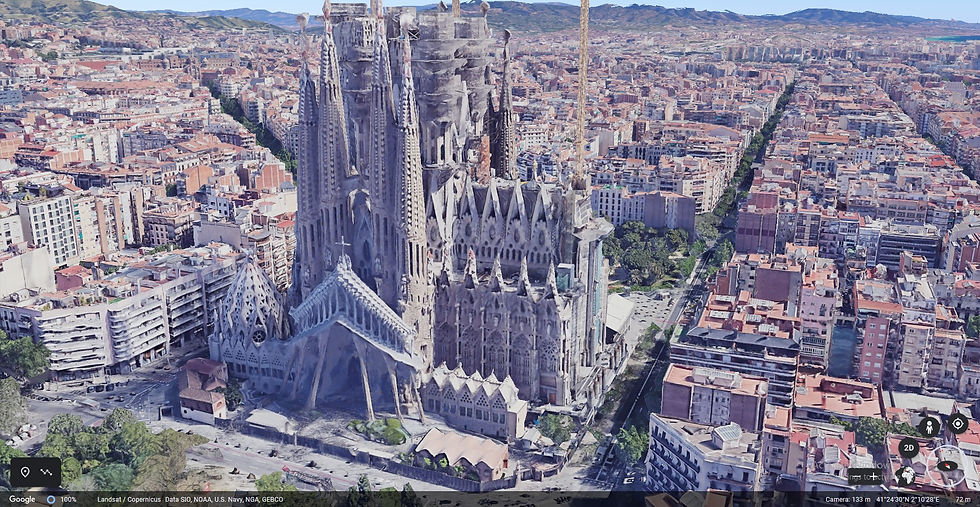Human Shadow Residue Soils the Feet of the Sagrada Familia
- Justus Hayes
- Sep 9, 2020
- 4 min read
La Sagrada Familia is undoubtedly one of the architectural wonders of the world. I've had the privilege of visiting it twice, once in 1988 and again during the Great Big Trip in 2005. It had a tremendous impact on me, especially during my 2005 visit. Construction has progressed quite a bit in the past fifteen years, and I love seeing that progress through current photos and this somehow appropriately wonky 3D rendering of the basilica on Google Earth.
While I was zooming around the cathedral yesterday, I noticed that the sidewalks surrounding it are infested with a particularly virulent case of Human Shadow Residue. I first noticed HSR in action a while back and mentioned it in a post - Render Unto Caesar the Things That Map Poorly. It's what happens when Google Earth's algorithms erase the people from their rendered models of physical reality but leave their shadows behind. They have little difficulty with removing the people; we are fairly speck-like at the closest view and highest resolution. You can see us all over the place on Google Maps:

It's trite but true that we look like ants from this distance. It's certainly obvious that we are alive and mobile, what with our clustering, swarming, parading, wandering. For reasons undetermined at the moment, Google Earth execs didn't like that look. Too messy, perhaps. It turns out, though, that the shadows we make are a problem for those people-removing algorithms. For one, shadows are usually much larger than the people creating them when seen from above. You are just a speck, but your shadow at 4:00 p.m. on a sunny day stretches out and occupies much more 2D real estate than a birds-eye view of your head and shoulders. Another problem is length variability; shadows range from a puddle at our feet to hugely elongated as the sun lowers in the sky. Shadows also vary in intensity depending on how much cloud there is at the time.

The end result is a kind of grey, smudgy residue that stains the surfaces of the rendered Google Earth world, leftover shadows imperfectly scrubbed away. This feels a bit poignant and eerie to me when considered on an individual basis. Consider the scattered pedestrians enjoying a presumably beautiful late afternoon on the Terreiro do Paço in Lisbon, Portugal. They are just living their lives with no idea that one day their likenesses will be manipulated in this way:
That's Google Maps, with people, above, and the new Google Earth, without people, below.

The multiple shadows thrown by the monument in the middle of the square above indicate that a minimum of four image captures at different times were used to construct the model's skin. This doesn't surprise me, as I imagine that to skin all sides of a virtual building requires satellite images from multiple approaches and angles. This is confirmed by the close up at right of an area beside the basilica; notice the four shadows cast by the sign. Also notice that you can't actually see the sign. Typical!
The multiple image captures don't affect how our personal shadows are recorded in most cases; we move around too much and too quickly. It does mean, though, that multiple configurations of people are captured at different times in the same geographic location. It's like a time lapse photo of a busy train station; the comings and goings of people blur into a fog of motion over time, except in this case it's the blurring and overlapping of just our shadows.


This, to me, distinctly unsettling effect is most noticeable where large numbers of people gather, such as the areas around the entrances to the Sagrada Familia. It makes me think of conglomerations of things physically insubstantial, like spider webs or frog eggs. Get enough of it together and it makes a thing. What's really weird is that Google Earth treats these accretions as if they had depth and height. Their distance-finding radar (I assume that's how they map topography) pings off the accumulated heads of the crowd, making it think there is a physical mass there. The only images it has to skin that mass, though, are the scrubbed shadow images. It's as if the crowd was hiding under a blanket of multiple, overlapping shadows, an undulating organic mass that puts me in mind of frog eggs even more. Or maybe a slime mold.

Creepy.

The above is essentially the same view in Street View. Substantially less creepy.

I included this one because I love me a good Street View glitch. There are a ton of these in the area, almost all of them involving diagonal legs.
While we are looking at the above image, take a moment to admire the grid pattern on the sidewalk. Notice that it is unbroken, straight, and uniform despite overlapping photos (that's what produces the glitch in the first place). Very impressive!

This is as close as we can get to the little plaza above the entrance. These are some of the clearest examples of human shadows in the mix that I have found yet.

The other side.



What we have here is very interesting, because I'm pretty sure that multicoloured mass under the tree is a small crowd of people, probably waiting for the deformed double-decker tour bus just down the block.

This is the first time in all of my Google Earth wanderings that I have seen actual people rendered, and not just their shadows. They don't look so bad to me.






Comments